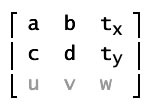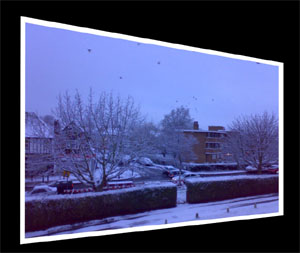
package
{
import sandy.util.*;
import flash.display.*;
import flash.display.Sprite;
import flash.display.Shape;
import flash.display.Graphics;
import flash.display.DisplayObject;
import flash.display.StageAlign;
import flash.display.StageScaleMode;
import flash.display.Bitmap;
import flash.display.Loader;
import flash.events.Event;
import flash.net.URLRequest;
import flash.geom.Point;
import flash.geom.Matrix;
import flash.geom.Rectangle;
import flash.display.BitmapData;
[SWF(width=”1024″, height=”768″, backgroundColor=”#000000″)]
public class App extends Sprite
{
private var _shape:Shape;
private var _refshape:Shape;
private var _loader:Loader = new Loader();
private var _reflectionBitmap:Bitmap;
public function App()
{
init();
}
private function init():void
{
stage.scaleMode = StageScaleMode.NO_SCALE;
stage.align=StageAlign.TOP_LEFT;
_loader.contentLoaderInfo.addEventListener(Event.COMPLETE, onComplete);
_loader.load(new URLRequest(“24012007010.jpg”));
}
private function onComplete(event:Event):void {
var loadedImage:Bitmap = Bitmap(_loader.content);
_shape = new Shape();
_shape.graphics.lineStyle(0,0X0000FF,1);
_shape.graphics.drawRect(0, 0, loadedImage.width, loadedImage.height);
addChild(_shape);
_shape.x=200;
_shape.y=100;
_refshape = new Shape();
_refshape.graphics.lineStyle(0,0X0000FF,1);
_refshape.graphics.drawRect(0, 0, loadedImage.width, loadedImage.height);
addChild(_refshape);
_refshape.x=200;
_refshape.y=100;
var distort:DistortImage = new DistortImage();
distort.container = _shape;
distort.target = loadedImage;
distort.smooth = true;
distort.initialize( 5, 5, null );
distort.setTransform(-76,-80,500,0,500,334,-76,398);
distort.render();
createReflectionBitmap(loadedImage);
}
private function createReflectionBitmap(target:DisplayObject):void {
var Falloff:Number = 0.6;
var rect: Rectangle = new Rectangle(0, 0, target.width, target.height);
var alphaGradientBitmap:BitmapData = new BitmapData(target.width, target.height, true, 0x00000000);
var gradientMatrix: Matrix = new Matrix();
var gradientShape: Shape = new Shape();
gradientMatrix.createGradientBox(target.width, target.height * Falloff, Math.PI/2,
0, target.height * (1.0 – Falloff));
gradientShape.graphics.beginGradientFill(GradientType.LINEAR, [0xFFFFFF, 0xFFFFFF],
[0, 1], [0, 255], gradientMatrix);
gradientShape.graphics.drawRect(0, target.height * (1.0 – Falloff),
target.width, target.height * Falloff);
gradientShape.graphics.endFill();
alphaGradientBitmap.draw(gradientShape, new Matrix());
var targetBitmap:BitmapData = new BitmapData(target.width, target.height, true, 0x00000000);
targetBitmap.fillRect(rect, 0x00000000);
targetBitmap.draw(target, new Matrix());
var reflectionData:BitmapData = new BitmapData(target.width, target.height, true, 0x00000000);
reflectionData.fillRect(rect, 0x00000000);
reflectionData.copyPixels(targetBitmap, rect, new Point(), alphaGradientBitmap);
_reflectionBitmap = new Bitmap(reflectionData);
_reflectionBitmap.alpha = .3;
var m:Matrix = _refshape.transform.matrix;
var position:Point = new Point(m.tx, m.ty);
m.tx = position.x;
m.ty = position.y;
m.d = -1;
m.ty = _refshape.height*3;
_refshape.transform.matrix = m;
var distortn:DistortImage = new DistortImage();
distortn.container = _refshape;
distortn.target = _reflectionBitmap;
distortn.smooth = true;
distortn.initialize( 5, 5, null );
distortn.setTransform(-76,300,500,350,500,695,-76,630);
distortn.render();
}
}
}
[Edit: The above is just a proof of concept and the code is begging for refactorisation;)]










